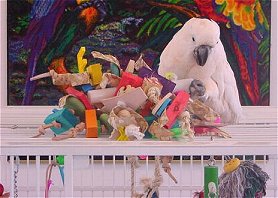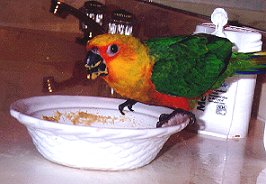
- To step up to my hand on command and to step down on command. I use the simple words Up and Down. This training is the most important thing I can teach them. When this is learned, I consider my parrots hand trained and they are now better companions for me and more trainable for future lessons. Down is not a command my cockatoos like and is the harder command to teach. I put my hand into the legs of the baby gently pushing saying Up and they have to or they fall off. From there, they always progress to putting that foot out and stepping up readily when they mature.
- To come when called. Parrots are not obedient and I don’t expect them to be. Coming when called is not a natural thing for them to learn. But they are loving and if you teach a baby parrot to come when called to get loved, it can help you find them if they are lost. If they are ever in danger, you can call them out to safety.
- To wear their harness and leash. It is not considered safe to leave a parrot unattended when wearing a harness and leash. If you want to take them outside with you, a wing clip is not enough. A gust of wind can give them lift and they are gone from your arm even with a clip. The harness and leash will prevent this from occurring and is designed to keep the person and bird from becoming separated outside. I put the harness and leash on my baby birds and take them immediately outside to the nice sunshine. They quickly learn to associate that leash with fun and raise their wings to assist me in getting the harness onto them easier.

- To play with toys. Boredom is one of the critical parrot stresses that a responsible parrot owner must help a parrot in a cage overcome. Teach them as young birds to play with toys. If they seem uninterested, then you play with them with the bird watching and try to make it an interactive event. Laugh and ring the bell and show the bird how fun toys can be.
- To eat a variety of foods. Offer a number of foods daily. Praise the bird when they eat something new. Tie the broccoli up with a piece of birdy leather, skewer the apple, and always try to make new foods fun. A varied, healthy diet is producing a generation of spectacular parrots that feel good about themselves and their person too.
- To bite toys and not me. It is normal for a baby parrot to put things in their beaks. They explore with them. Be sure there are toys to grab fast near you to give a parrot so they will not learn to beak your fingers.
- That sitting on my shoulder is a treat, not a right. If a parrot is alarmed for its safety and/or yours, it will pinch bite you. Sometimes this bite is hard. Face bites are painful, so keep them off your shoulder for your safety.
- To do conditioned screaming. Establish a time and area where your bird can scream all it wants. For my flock, I gather them all in the den, they sit on the back of a chair or the breakfast bar stools, and when the final choir director cockatoo is in place, they know it is time to scream together.
- To go to other people that say “step up.” Whether or not I can teach this has been dependent on the parrot. Two of my parrots as baby birds refused to go to others and still refuse.
- To like a towel. Play peek a boo with a towel. There are times they will have to be toweled like at the Veterinarian. If they are not afraid of a towel, then there is less stress for them.

- To eat from a spoon and from a bowl. The immediate benefit from spoon feeding is the parrot bonds better. The long term effect is you can get them to try new foods from a spoon and give medication if needed. If they have a bowl they identify as theirs, then they will try new foods more readily from it.
- Their names, parrots need an identity. My parrots quickly caught on to the idea that I had a name, the dog had a name, and so did they. Pet names like “Baby” are fine, but teach them what their name is.
- To step up to a stick or a towel over my hand. Baby birds seem to learn this easier than adults, so start young in case someone ever has to handle them that is afraid of them, the stick can be a great tool to get the bird to cooperate by stepping up to it.
- To take food from your hand. This will help keep them tame. It also allows you to introduce new foods.
- The concept of being gentle with those mighty beaks. When they beak too hard, tell them gentle and stroke their beak and try to get the idea across to be gentle with you. The concept of telling a parrot “no bite” has not worked with my baby parrots.
- Stop when told, by holding your hand palm-up in the traditional stop symbol, and saying stop. It could save them an injury.
There is a concept you may want to consider teaching. It is the concept of “it’s hot” or “it’s dangerous.” Stoves and ceiling fans are a hazard for indoor birds. Rattle the pots on the stove, drop lids there, make lots of disturbing noises so that is considered an area to avoid by your parrots. Take a broom and knock around the ceiling fan, making noise, causing alarm in the bird. Perhaps teaching the concept can help keep them accident free. It is teaching by fear. Unless it is necessary in your parrot’s environment, I would avoid teaching by fear.There are probably lots of other lessons you will want to try like teaching your parrot to talk. Be consistent with the training. Build on their strengths. One of my baby parrots was so communicative she learned to answer a few simple questions. Today, I still feel so happy when I ask her “What’s your name” and she says, “Vanilla.” Another idea to teach is to speak to me before I say step up to take them out of the cage. Open the door, lean in expectantly and say hello, hello, and wait to hear if your bird will make a sound in answer. A baby bird sometimes only squeals. Then say “Step Up” in your best praise tone and hug that baby bird close when you get him/her out. The effort to communicate with you has been rewarded. To teach the lessons listed above and others designed to enhance the bird’s strengths enriches my life and the parrots.
Your expectations should be reasonable when teaching a parrot. No one can teach a parrot to never scream. Parrots do that. It is instinctual behavior. Modifying the behavior like creating conditioned screaming is the reasonable way. One disappointment to me is my male Moluccan Cockatoo has never taken food from my hand. It is not reasonable for me to insist he do this, but I am consistent and offer him food at least once each day from my hand.
Be careful of teaching a lesson accidentally. My first parrot would bite when he was a baby. I would take him back to his cage for a time out. He learned that when he was tired or thirsty he should bite me so he could go back to his cage. Ending each interactive session on a positive note is the way to teach lessons to a parrot. An easy way for me to do this is to take them to see the bird in the mirror. They all like to see their refelction in the mirror. After they admire themselves a while, I return them to their cage and I always tell them, “Good Bird.”
If there is anything sweeter than a baby bird, it is that same bird after it has grown into a well-adjusted companion parrot for your life-long enjoyment.
Enjoy your baby bird!


